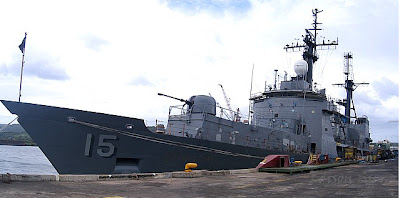19 Februari 2013
PF-15 BRP Gregorio del Pilar (photo : ed sy)
MANILA, Philippines --- A Department of National Defense (DND) official revealed that a committee is now studying the possibility of arming the Philippine Navy’s (PN) two Hamilton-class cutters with anti-ship missiles.
However, the official refused to disclose the type of anti-ship missiles currently being evaluated by the committee, but he said that once installed, this will give the BRP Gregorio Del Pilar (PF-15) and soon to arrive BRP Ramon Alcaraz (PF-16) more capability in protecting the country's maritime domain.
He added, having the anti-missiles will also give BRP Del Pilar and BRP Alcaraz more firepower in engaging would-be poachers and intruders.
Earlier, defense officials identified the Harpoon as the ideal missile system for the PN's Hamilton-class cutters noting that the weapon was already deployed aboard the USCGC Mellon, the sister ship of the BRP Gregorio Del Pilar and BRP Ramon Alcaraz, in January 1990.
While the ship's anti-submarine warfare (ASW) suite and Harpoon capability were removed in the latter part of the 1990s, this served as a proof of capability for all USCG cutters.
The Harpoon is an all-weather, over-the-horizon, anti-ship missile system, developed and manufactured by McDonnell Douglas (now Boeing Defense, Space & Security).
The regular Harpoon uses active radar homing, and a low-level, sea-skimming cruise trajectory to improve survivability and lethality. The missile's launch platforms include: Fixed-wing aircraft (the AGM-84, without the solid-fuel rocket booster); Surface ships (the RGM-84, fitted with a solid-fuel rocket booster that detaches when expended, to allow the missile's main turbojet to maintain flight); Submarines (the UGM-84, fitted with a solid-fuel rocket booster and encapsulated in a container to enable submerged launch through a torpedo tube); and Coastal defense batteries, from which it would be fired with a solid-fuel rocket booster.
In 2004, Boeing delivered the 7,000th Harpoon unit since the weapon's introduction in 1977. The missile system has also been further developed into a land-strike weapon, the standoff land attack missile.
The regular Harpoon uses active radar homing, and a low-level, sea-skimming cruise trajectory to improve survivability and lethality. The missile’s launch platforms include:
* Fixed-wing aircraft (the AGM-84, without the solid-fuel rocket booster).
* Surface ships (the RGM-84, fitted with a solid-fuel rocket booster that detaches when expended, to allow the missile's main turbojet to maintain flight).
* Submarines (the UGM-84, fitted with a solid-fuel rocket booster and encapsulated in a container to enable submerged launch through a torpedo tube).
* Coastal defense batteries, from which it would be fired with a solid-fuel rocket booster.
(Manila Bulletin)
PF-15 BRP Gregorio del Pilar (photo : ed sy)
MANILA, Philippines --- A Department of National Defense (DND) official revealed that a committee is now studying the possibility of arming the Philippine Navy’s (PN) two Hamilton-class cutters with anti-ship missiles.
However, the official refused to disclose the type of anti-ship missiles currently being evaluated by the committee, but he said that once installed, this will give the BRP Gregorio Del Pilar (PF-15) and soon to arrive BRP Ramon Alcaraz (PF-16) more capability in protecting the country's maritime domain.
He added, having the anti-missiles will also give BRP Del Pilar and BRP Alcaraz more firepower in engaging would-be poachers and intruders.
Earlier, defense officials identified the Harpoon as the ideal missile system for the PN's Hamilton-class cutters noting that the weapon was already deployed aboard the USCGC Mellon, the sister ship of the BRP Gregorio Del Pilar and BRP Ramon Alcaraz, in January 1990.
While the ship's anti-submarine warfare (ASW) suite and Harpoon capability were removed in the latter part of the 1990s, this served as a proof of capability for all USCG cutters.
The Harpoon is an all-weather, over-the-horizon, anti-ship missile system, developed and manufactured by McDonnell Douglas (now Boeing Defense, Space & Security).
The regular Harpoon uses active radar homing, and a low-level, sea-skimming cruise trajectory to improve survivability and lethality. The missile's launch platforms include: Fixed-wing aircraft (the AGM-84, without the solid-fuel rocket booster); Surface ships (the RGM-84, fitted with a solid-fuel rocket booster that detaches when expended, to allow the missile's main turbojet to maintain flight); Submarines (the UGM-84, fitted with a solid-fuel rocket booster and encapsulated in a container to enable submerged launch through a torpedo tube); and Coastal defense batteries, from which it would be fired with a solid-fuel rocket booster.
In 2004, Boeing delivered the 7,000th Harpoon unit since the weapon's introduction in 1977. The missile system has also been further developed into a land-strike weapon, the standoff land attack missile.
The regular Harpoon uses active radar homing, and a low-level, sea-skimming cruise trajectory to improve survivability and lethality. The missile’s launch platforms include:
* Fixed-wing aircraft (the AGM-84, without the solid-fuel rocket booster).
* Surface ships (the RGM-84, fitted with a solid-fuel rocket booster that detaches when expended, to allow the missile's main turbojet to maintain flight).
* Submarines (the UGM-84, fitted with a solid-fuel rocket booster and encapsulated in a container to enable submerged launch through a torpedo tube).
* Coastal defense batteries, from which it would be fired with a solid-fuel rocket booster.
(Manila Bulletin)
